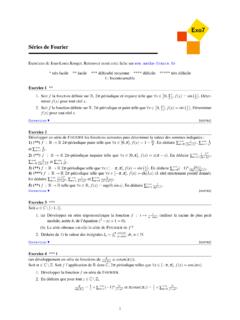Transcription of Analysis of Fourier series using Python Code
1 Analysis of Fourier series using Python code Dr. Shyamal Bhar Department of Physics Vidyasagar College for Women Kolkata 700 006. We know that there are many ways by which any complicated function may be expressed as power series . This is not the only way in which a function may be expressed as a series but there is a method of expressing a periodic function as an infinite sum of sine and cosine functions. This representation is known as Fourier series . The computation and study of Fourier series is known as harmonic Analysis and is useful as a way to break up an arbitrary periodic function into a set of simple harmonic terms that can be plugged in, solved individually, and then recombined to obtain the solution to the original problem or an approximation to it to whatever accuracy is desired. Unlike Taylor series , a Fourier series can describe functions that are not everywhere continuous and/or differentiable. There are other advantages of using trigonometric terms. They are easy to differentiate and integrate and each term contain only one characteristic frequency.
2 Analysis of Fourier series becomes important because this method is used to represent the response of a system to a periodic input and the response depends on the frequency content of the input. Dirichlet Conditions: The conditions that a function f x may be expressed as Fourier series are known as the Dirichlet conditions. The conditions are i) The function must be periodic ii) It must be single valued and continuous. There may a finite number of finite discontinuities iii) It must have only a finite number of maxima and minima within one period iv) The integral over one period of f x must converge. Fourier series makes of the orthogonality relationships of the sine and cosine functions. The integral over one period of the product of any two terms have the following properties: Dr. Shyamal Bhar, Department of Physics, Vidyasagar College for Women, Kolkata 700 006 1. x0 L. 2 nx 2 mx . sin cos dx 0 for all m and n x0 L L . L for m n 0. x0 L L. 2 nx 2 mx . cos cos dx for m n 0.
3 X0 L L 2. 0 for m n L for m n 0. x0 L L. 2 nx 2 mx . sin sin dx for m n 0. x0 L L 2. 0 for m n So the Fourier series of the function f x over the periodic interval 0, L is written as a0 2 nx 2 nx . f x an cos bn sin . 2 n 1 L L . where an and bn are constants called the Fourier coefficients and L. 2. a0 . L f x dx . 0. L. 2 2 nx . an . L 0. f x cos dx L . L. 2 2 nx . bn f x sin dx . L0 L . The Fourier series of the function f x over the periodic interval L, L is written as a0 nx nx . f x an cos bn sin . 2 n 1 L L . where, Dr. Shyamal Bhar, Department of Physics, Vidyasagar College for Women, Kolkata 700 006 2. L. 1. a0 f x dx . L L. L. 1 nx . an f x cos dx L L L . L. 1 nx . bn f x sin dx . L L L . The Fourier series of the function f x over the periodic interval , is written as a0 . f x an cos nx bn sin nx . 2 n 1. where, . 1. a0 f x dx .. 1. an f x cos nx dx .. 1. bn f x sin nx dx .. built-in piecewise continuous functions such as square wave, sawtooth wave and triangular wave 1.
4 Module (x, duty= ). Return a periodic square-wave waveform. The square wave has a period 2*pi, has value +1 from 0 to 2*pi*duty and -1 from 2*pi*duty to 2*pi. duty must be in the interval [0,1]. Dr. Shyamal Bhar, Department of Physics, Vidyasagar College for Women, Kolkata 700 006 3. 2. module (x, width=1). Return a periodic sawtooth or triangle waveform. The sawtooth waveform has a period 2*pi, rises from -1 to 1 on the interval 0 to width*2*pi, then drops from 1 to -1 on the interval width*2*pi to 2*pi. width must be in the interval [0, 1]. Triangular wave from sawtooth signal Dr. Shyamal Bhar, Department of Physics, Vidyasagar College for Women, Kolkata 700 006 4. 3. () module (M, sym=True). Return a triangular window. w : ndarray The window, with the maximum value normalized to 1 (though the value 1 does not appear if M is even and sym is True). Example -1. # Fourier series Analysis for a sqaure wave function # user defined function import numpy as np from import square import as plt from import simps Dr.
5 Shyamal Bhar, Department of Physics, Vidyasagar College for Women, Kolkata 700 006 5. L=4 # Periodicity of the periodic function f(x). freq=4 # No of waves in time period L. dutycycle= samples=1000. terms=100. # Generation of square wave x= (0,L,samples,endpoint=False). y=square( * *x*freq/L,duty=dutycycle). # Calculation of Fourier coefficients a0= *simps(y,x). an=lambda *simps(y* (2.* *n*x/L),x). bn=lambda *simps(y* (2.* *n*x/L),x). # sum of the series s=a0/2.+sum([an(k)* (2.* *k*x/L)+bn(k)* (2.* *. k*x/L) for k in range(1,terms+1)]). # Plotting (x,s,label=" Fourier series "). (x,y,label="Original square wave"). ("$x$"). ("$y=f(x)$"). (loc='best',prop={'size':10}). ("Sqaure wave signal Analysis by Fouries series "). (" "). (). Dr. Shyamal Bhar, Department of Physics, Vidyasagar College for Women, Kolkata 700 006 6. Example-2 : # Fourier series Analysis for a sawtooth wave function import numpy as np from import square,sawtooth import as plt from import simps L=1 # Periodicity of the periodic function f(x).
6 Freq=2 # No of waves in time period L. width_range=1. samples=1000. terms=50. # Generation of Sawtooth function x= (0,L,samples,endpoint=False). y=sawtooth( * *x*freq/L,width=width_range). # Calculation of Co-efficients a0= *simps(y,x). an=lambda *simps(y* (2.* *n*x/L),x). bn=lambda *simps(y* (2.* *n*x/L),x). # Sum of the series s=a0/2.+sum([an(k)* (2.* *k*x/L)+bn(k)* (2.* *. k*x/L) for k in range(1,terms+1)]). # Plotting (x,s,label=" Fourier series "). (x,y,label="Original sawtooth wave"). ("$x$"). ("$y=f(x)$"). (loc='best',prop={'size':10}). ("Sawtooth wave signal Analysis by Fouries series "). (" "). (). Dr. Shyamal Bhar, Department of Physics, Vidyasagar College for Women, Kolkata 700 006 7. Example -3: # Fourier series Analysis for a Triangular wave function import numpy as np from import square,sawtooth,triang import as plt from import simps L=1 # Periodicity of the periodic function f(x). samples=501. terms=50. # Generation of Triangular wave x= (0,L,samples,endpoint=False).
7 Y=triang(samples). # Fourier Coefficients a0= *simps(y,x). an=lambda *simps(y* (2.* *n*x/L),x). bn=lambda *simps(y* (2.* *n*x/L),x). # series sum s=a0/2.+sum([an(k)* (2.* *k*x/L)+bn(k)* (2.* *. k*x/L) for k in range(1,terms+1)]). # Plotting (x,s,label=" Fourier series "). (x,y,label="Original Triangular wave"). Dr. Shyamal Bhar, Department of Physics, Vidyasagar College for Women, Kolkata 700 006 8. ("$x$"). ("$y=f(x)$"). (loc='best',prop={'size':10}). ("Triangular wave signal Analysis by Fouries series "). (" "). (). Example-4. # Fourier series Analysis for a sawtooth wave function # User defined function import numpy as np import as plt from import simps L= # half wavelength, Wavelength=2L. freq=2 # frequency samples=1001. terms=300. # Defining sawtooth function x= (-L,L,samples,endpoint=False). f=lambda x: (freq*x%(2*L)-L)/L. # Fouriers coefficients a0= *simps(f(x),x). an=lambda *simps(f(x)* (1.* *n*x/L),x). bn=lambda *simps(f(x)* (1.* *n*x/L),x). Dr. Shyamal Bhar, Department of Physics, Vidyasagar College for Women, Kolkata 700 006 9.
8 # series sum xp=4*x s=a0/2.+sum([an(k)* (1.* *k*xp/L)+bn(k)* (1.* *k*xp/L) for k in range(1,terms+1)]). # Plotting (xp,s,label=" Fourier series "). (xp,f(xp),label="Original sawtooth wave"). (loc='best',prop={'size':10}). (" "). (). Example-5: # Fourier series Analysis for a square wave function # User defined function import numpy as np import as plt from import simps L= # half wavelength, Wavelength=2L. freq=2 # frequency samples=1001. terms=300. Dr. Shyamal Bhar, Department of Physics, Vidyasagar College for Women, Kolkata 700 006 10. # Generating Square wave x= (-L,L,samples,endpoint=False). F=lambda x: ([-1 if -L<=u<0 else 1 for u in x]). f=lambda x: F(freq*x%(2*L)-L). # Fourier Coefficients a0= *simps(f(x),x). an=lambda *simps(f(x)* (1.* *n*x/L),x). bn=lambda *simps(f(x)* (1.* *n*x/L),x). # series sum xp=4*x s=a0/2.+sum([an(k)* (1.* *k*xp/L)+bn(k)* (1.* *k*xp/L) for k in range(1,terms+1)]). #Plotting (xp,s,label=" Fourier series "). (xp,f(xp),label="Original Square wave").
9 (loc='best',prop={'size':10}). (" "). (). Example -6. # Fourier series Analysis for a Arbitrary waves function # User defined function import numpy as np Dr. Shyamal Bhar, Department of Physics, Vidyasagar College for Women, Kolkata 700 006 11. import as plt from import simps L= # half wavelength, Wavelength=2L. freq=2 # frequency samples=1001. terms=300. # Generating wave x= (-L,L,samples,endpoint=False). F=lambda x: ([u**2 if -L<=u<0 else 1 if 0<u< else 0. for u in x]). #F=lambda x: abs( (2* *x)). f=lambda x: F(freq*x%(2*L)-L). # Fourier Coefficients a0= *simps(f(x),x). an=lambda *simps(f(x)* (1.* *n*x/L),x). bn=lambda *simps(f(x)* (1.* *n*x/L),x). # series sum xp=x s=a0/2.+sum([an(k)* (1.* *k*xp/L)+bn(k)* (1.* *k*xp/L) for k in range(1,terms+1)]). #Plotting (xp,s,label=" Fourier series "). (xp,f(xp),label="Original wave"). (loc='best',prop={'size':10}). (" "). (). Dr. Shyamal Bhar, Department of Physics, Vidyasagar College for Women, Kolkata 700 006 12. Dr. Shyamal Bhar, Department of Physics, Vidyasagar College for Women, Kolkata 700 006 13.









